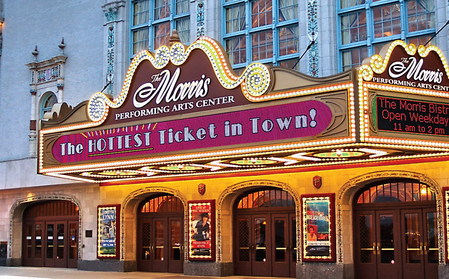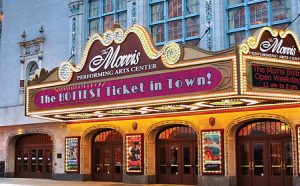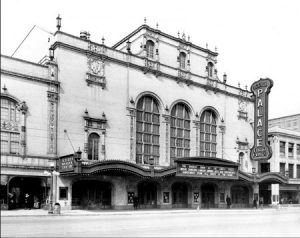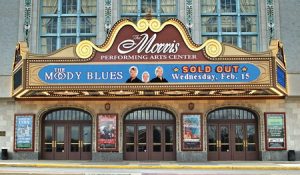Theatre marquees have always been fixtures that “announce” the magic of stage and screen. When an agent talks about getting a star’s name in lights, this is the focal point of that honor.
Marquees originally comprised a readerboard with a large, backlit, translucent display and changeable, black, plastic letters that were rearranged for each new program. Today, LED message centers often direct the public to the current features.
Theatre marquees have evolved into electronic displays that can present horizontal text messages, full-color graphics and high-definition video. Even older, existing movie palaces are adding LED glitz to their facades. Often, these older theaters are landmarked, but the architectural distinction provides a major challenge: How do you fabricate a modern, electronic sign system and make it look historic? ST explores how several theatre venues have embraced LED displays to modernize their show promotions.
LED-based marquees are becoming a de-facto standard for movie-theater facades, whether they’re new or updated. David Ramirez, Brookings, ND-based Daktronics Inc. New York City senior account executive, said an LED theater marquee frees the theater staff from climbing a ladder with a box of plastic ladders to change out marquee displays. Now, with a computer, keyboard and a few mouse clicks, marquees can be updated with new titles and show times to accommodate ongoing program changes.
On a basic level, a typical LED message-display system forms a horizontal band that wraps around the marquee front. The monochromatic, text displays stream ongoing information about film titles and ratings and sometimes, a movie star’s name.
Advertisement
Full-color screens, which are becoming more affordable, present greater marketing possibilities. Ramirez said, “By adding color and animation to the marquee, the displays become more effective; more people notice them and hopefully buy more tickets to the featured shows.”
Theater operators who have graphic-based displays can easily update their marquees with special websites, where they can select appropriate graphics, import those files and transfer the content to their marquees.
Morris Performing Arts Center
The Morris Performing Arts Center, which opened in 1921 in South Bend, IN (see ST, October 2006, page 36), also balanced its modernization with its landmark status. Originally named the Palace Theater, the multi-purpose theater offered live shows and vaudeville acts. In 1999, after 78 years, and a closing and reopening, the Morris (plus its marquee) was renovated.
After a 26-month renovation, in May 2000, Dennis J. Andres became the center’s new executive director. He noted the building no longer had a significant marquee. “If we’re going to make it out here, we need to have a marquee that befits the building,” Andres said.
The 2,560-seat center decided to replace the original marquee with an electronic version that could inform the community and passersby about current and upcoming shows and special events. Center officials selected a Daktronics’ full-color, 3 3 39-ft. ProAd display, which can show pre-recorded video, animation and graphics as part of their overall event promotion. The center display shows still and moving images, and strobing and twinkling light effects. The side, 3 3 10-ft., full-color Galaxy LED boards can also display text, as well as graphics and animation.
Advertisement
“We’re a bit more constrained with use of graphic effects in what we can put on the side screens,” Andres said.
Wagner Electric Sign Co. (Elyria, OH) designed and fabricated the marquee, and partnered with North American Signs Inc. (South Bend) to install it.
Andres compared content preparation to designing billboard messages. “You have to learn about the proper use of color and animation, and the available viewing time [dwell time] for vehicles passing by to create readable and memorable messages.
“When we first started using our electronic marquee, we thought we would need about 10 minutes to put up some messages about our current and upcoming shows. Wrong. Once we started doing this, we discovered it took us about 20 hours a week to program the three LED marquee screens the way we wanted.”
In addition to an image of a star performer(s), the marquee promotes each show with three types of messages: a pre-show pitch, a “show is coming” reminder and a “don’t miss” display.
Andres said, “There are subtle differences in these message statements, but we don’t want to hammer the public with the same, continuous messages all the time. Instead, we alternate several similar, but slightly different, messages for each show. If we’re lucky, the best and final message, ‘Sold Out,’ will be displayed as soon as it happens.”
Advertisement
Message design is also influenced by seasonal messages and colors.
A comparison of the Morris’ first six months of 2005 (when it didn’t have the new marquee) and the first six months of 2006 (after the new marquee was installed) shows attendance had increased by at least 60%. Andres attributes at least half the increase to the marquee.
Morris Marquee’s Reconstruction Process
The reconstructed Morris marquee was to be attached in the same general manner and location as the original, although the width of the updated version is slightly smaller. The theater-design group sought a variance so its marquee structure could project 15 ft. over the sidewalk, nearly double the 8-ft. maximum. The design also requested the use of chaser lights on the marquee and around the front-facade display cases. Furthermore, they wanted to install a full-color LED videoscreen within the marquee’s front display area.
To install the marquee, the design group dealt with the following organizations:
Morris Entertainment Inc.’s board of directors had to be convinced that acquiring an electronic marquee display was worth the investment.
The Historic Preservation Commission (HPC) of South Bend checked if the updated design and use of an electronic display fit within the architect’s motif of the building’s original design.
The Board of Zoning Appeals of the City of South Bend dealt with the use of theatrical chase lights, which are prohibited within the marquee, and the marquee’s overall size. The installation of the electronic marquee also required the approval of all the surrounding businesses.
St. Joseph County/South Bend’s Design Review Committee reviewed the theater design in relation to the overall downtown cityscape.
DNR-Div. of Historic Preservation and Archaeology, an approval organization, received the final design (blueprints, renderings, elevation drawings, wiring diagrams, color spec sheets, etc.) to confirm that the design met with Landmark Committee criteria.
Dennis Andres, the Morris executive director, said, “Once they understood the full scope of the new Morris marquee, the governing South Bend regulatory organizations supported and approved our efforts to install a new a state-of-the-art theater display on the face of our building.



 Tip Sheet2 days ago
Tip Sheet2 days ago
 Business Management1 week ago
Business Management1 week ago
 Women in Signs1 week ago
Women in Signs1 week ago
 Real Deal3 days ago
Real Deal3 days ago
 Editor's Note1 week ago
Editor's Note1 week ago
 Maggie Harlow2 weeks ago
Maggie Harlow2 weeks ago
 Line Time1 week ago
Line Time1 week ago
 Product Buying + Technology1 week ago
Product Buying + Technology1 week ago












